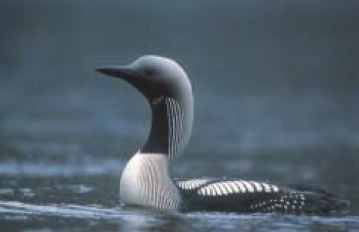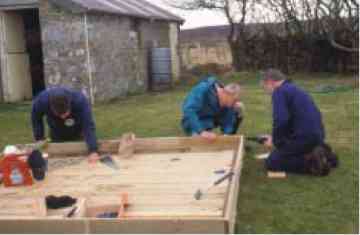|
RIVER LOCH
AND WETLAND
Introduction
Water is a key feature of the
Caithness landscape, with distinctive wildlife as well as social and
economic uses.
Rivers and lochs are important for
recreation and sport, and the quality and quantity of our waters is
heavily dependent on the management of habitats within their catchments.
In addition to the small areas of wetland that exist on many farms and
crofts, Caithness holds some large areas of marsh, fen and reedbed, which
attract rare birds and plants.
Biodiversity Objectives
- Maintain favourable water quality status in
all water bodies.
- Retain and enhance all existing areas of
wetland and keep lochs and rivers in as natural a state as possible,
with no barriers to fish migration.
- Promote the use of practical guidance notes
and professional advice from government agencies. Encourage
responsible recreation (including angling, shooting, water sports)
wherever possible.
- Raise awareness of the importance of wetland
and open water habitats, and encourage local pride in the value of
the pristine freshwater environment of Caithness.
- Promote a holistic approach to freshwater
conservation by encouraging co-operation between land and water
users.
|
Rivers and
lochs
Habitats
and species
Caithness holds approximately 33.5
km2 of inland water, and its rivers and burns are highly regarded by local
people for their recreational, scenic and environmental value. These
pristine waters sustain important populations of Atlantic salmon, sea
trout, brown trout, sticklebacks, eels, European otters, water voles and
freshwater pearl mussels.
The county is bisected by its two
principal rivers, the
Wick and the Thurso. Their flood plains form a fertile band of land
running south-east and northwest through the county respectively. These
rivers along with the Forss, Berriedale, Langwell and Wester emanate from
mineral rich springs and peatland burns deep in the heart of Caithness.
In places, these rivers have cut
gullies, whose steep sides harbour rich vegetation including pyramidal
bugle and prostrate juniper. The nationally rare estuarine sedge (Wick
sedge) and holy grass can be found along the river banks.

Boats on Loch Watten
Caithness lochs range from
nutrient-poor peat lochans (oligotrophic) throughout the peatlands, to
nutrient-rich lochs (eutrophic) such as St Johns Loch. In between
are a number of lochs with intermediate nutrient levels (mesotrophic) such
as Loch Hempriggs.
The biodiversity of the lochs is
highly dependent on their water chemistry, which in turn is influenced by
the nature of the surrounding rocks and soils. A good number of lochs have
a base of calcium-rich, pale mud known as marl, and these lochs are
particularly rich in character.
Most Caithness lochs sustain
healthy populations of fish, notably brown trout, sticklebacks and eels,
while Loch Calder also has ferox trout and Arctic char. Some, like Loch
More, may contain salmon at certain times of the year.
Virtually all lochs have an immense diversity of
insect life including an abundance of mayfly, caddis fly and damsel flies.
Molluscs and crustaceans such as pea mussels, snails and freshwater
shrimps are abundant in the fertile lochs of Caithness. These
invertebrates form an important part of the diet of trout, ducks and
whooper swans. Trout in turn are eaten by otters and rarer birds like
black-throated, red-throated and great northern divers and osprey.

Brown trout
Aquatic plants range from bogbean to stonewort, and
many lochs contain weed beds, which provide important shelter for fish and
insects.
Main issues
-
Agricultural fertilisers and
pesticides, forestry run-off and septic tank leakage are all potential
sources of pollution and over enrichment in the aquatic environment. In
recent years, farming and forestry techniques have improved and existing
forestry plantations are being restructured to reduce their effect on
freshwaters.
-
Imprudent use of chemicals
including herbicides, pesticides and sheep dip can have a serious
detrimental effect on all water courses. Land managers should adhere to
existing codes of good practice regarding the use of such chemicals.
-
River and lochside developments,
bank engineering, gravel extraction, water supply schemes and hydropower
projects can irrevocably alter freshwater systems. Care must be taken not
to modify the structure and patterns of water flow to the detriment of
freshwater habitats and species. Road works and maintenance in particular
can sometimes interfere with the movement of migratory fish and animals
such as the otter.

Whooper swan |

Habitat Map
Main issues (cont)
-
In some areas, emergent and bank
side vegetation has been lost due to land drainage, flood defence, bank
protection works, cultivation or heavy grazing. Heavily trampled river
banks are susceptible to erosion during floods. Limiting grazing on banks
and planting deep rooted trees such as willow and alder will help to
stabilise the riversides, whilst installing water troughs discourages
animals from trampling at the waters edge. Agri-environmental grants may
be available to help pay for some of this work.
-
Invasive, non-native species of
fish, mammals, invertebrates and plants have caused problems for water
courses elsewhere in Scotland, and we should avoid releasing such species
in Caithness. Minnows are already an introduced non-native species in many
of the county’s lochs. Rainbow trout and American brook trout are stocked
in one fishery and the utmost care is needed to avoid any escape.
-
The migratory geese population may
possibly be a source of nutrient enrichment and associated damage to some
watercourses.
-
Acid rain remains a threat to our
watercourses, and organisations such as Scottish Natural Heritage are
working to quantify the size of this issue and how to address it.
-
There are many flooded quarries in
Caithness, which are now important habitats in their own right and could
be at risk from illegal dumping
and landfill.
Current
biodiversity projects
Members of Caithness and Sutherland Trout Angling
Group have conducted improvements to watercourses and bank habitats. For
example, some in-stream and bankside works were undertaken on a small
trout spawning burn at Broubster, including tree planting to stabilise
banks. 
Black-throated diver
The Caithness Ranger Service and RSPB Scotland
undertake a number of practical biodiversity projects such as the building
of rafts to help nesting birds like black-throated divers.
At St John’s Pool, rafts were constructed to help
breeding waders, and the relationship between breeding terns and waders,
and predators such as foxes and otters, is being monitored.

Raft building
The Thurso Rotary Club undertook a restoration project
on the River Thurso walkway. This has improved access in a manner
sensitive to the riverbank habitats.
Wick Community Council has initiated a paths project
to improve access and interpretation on the Wick Riverside.
Scottish Environmental Protection Agency and the Scottish Agricultural
College have been surveying the nutrient inputs to Loch Watten since
February 2000.
Opportunities for action
- Demonstrate the importance of freshwater
habitats and best practice with regard to instream and bank
management through practical projects, e.g. restoration of spawning
burns for wild trout and salmon, use of fenced buffer strips and
planting of broadleaved trees to prevent bank erosion.
- Undertake a demonstration ‘nutrient
budgeting and waste management’ project on a farm in the Loch Watten
catchment, building on the results of the survey mentioned above.
- Source funding for the upkeep of bird
nesting rafts on St. John’s Pool.
- Map sites with freshwater pearl mussels, and
ensure riparian management is appropriate to the needs of this
species.
- Raise awareness of the biodiversity value of
our rivers and lochs through e.g. a salmon life cycle car trail
along the Thurso River or a self-guided wildlife walk along the Wick
River.
- Disseminate best practice amongst all water
users, e.g. on field ditch management and pollution for farmers and
crofters, or on the non-use
of livebait for anglers.
- Investigate the impact of seals on the
salmon and trout populations at the mouth of the River Thurso, the
species interactions between ferox trout and Arctic char in Loch
Calder, and the viability of the sea trout population in the Loch of
Wester.
- Determine reasons for the decline in
breeding waders and Arctic terns at the Loch of Mey, and the effects
of nutrient enrichment on species living in and around watercourses.
- Monitor the impacts of the removal of
plantation forestry on the hydrology of lochs and watercourses
associated with the LIFE Peatlands Project.
- Conduct a countywide survey on water voles
and develop a strategy for controlling mink (not present in the
county yet).
- Undertake a study to investigate the
biodiversity value of flooded quarries in the county.
- Use the results of any surveys to feed into
management of these areas.
|
|
















